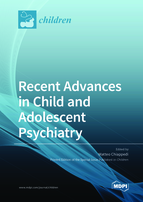Recent Advances in Child and Adolescent Psychiatry
A special issue of Children (ISSN 2227-9067). This special issue belongs to the section "Child Neurology".
Deadline for manuscript submissions: closed (5 June 2022) | Viewed by 64062
Special Issue Editor
2. Child Neuropsychiatry Unit, ASST Pavia, 27100 Pavia, Italy
Interests: child and adolescent neuropsychiatry; neurodevelopmental disorders; psychodynamic psychotherapy; treatments and outcomes
Special Issues, Collections and Topics in MDPI journals
Special Issue Information
Dear Colleagues,
Psychiatric disorders in children and adolescents are relevant both in terms of their prevalence (they are roughly estimated to affect about 20% of school-aged children and adolescents) and of their impact on the quality of life of the child/adolescent and their family, but also on the society as a whole.
Disorders affecting children and adolescents are increasingly seen as having highly specific features, and, therefore, require an equally specific approach despite the coexisting need to integrate contributions from other professions (e.g., pediatricians, psychiatrists, psychologists, and therapists of different sorts). However, the available data are still insufficient, especially for treatment options and too often therapeutic choices are still made based on studies conducted in adults. Even more important, the existence itself of some disorders is questioned especially outside the scientific field (e.g., ADHD).
This Special Issue will provide cutting edge data on all aspects of child and adolescent psychiatry, including etiopatogenesis, clinical characteristics and diagnosis, medical and neurological comorbidities (and psychiatric comorbidities of medical and neurological disorders), impact on patients/families/society (including school and other social groups), prognosis, and treatment options of the different disorders.
Dr. Matteo Alessio Chiappedi
Guest Editor
Manuscript Submission Information
Manuscripts should be submitted online at www.mdpi.com by registering and logging in to this website. Once you are registered, click here to go to the submission form. Manuscripts can be submitted until the deadline. All submissions that pass pre-check are peer-reviewed. Accepted papers will be published continuously in the journal (as soon as accepted) and will be listed together on the special issue website. Research articles, review articles as well as short communications are invited. For planned papers, a title and short abstract (about 100 words) can be sent to the Editorial Office for announcement on this website.
Submitted manuscripts should not have been published previously, nor be under consideration for publication elsewhere (except conference proceedings papers). All manuscripts are thoroughly refereed through a single-blind peer-review process. A guide for authors and other relevant information for submission of manuscripts is available on the Instructions for Authors page. Children is an international peer-reviewed open access monthly journal published by MDPI.
Please visit the Instructions for Authors page before submitting a manuscript. The Article Processing Charge (APC) for publication in this open access journal is 2400 CHF (Swiss Francs). Submitted papers should be well formatted and use good English. Authors may use MDPI's English editing service prior to publication or during author revisions.
Keywords
- Autism spectrum disorders
- ADHD
- Eating disorders
- Anxiety
- Mood disorders
- Psychotic disorders
- Psychosomatic disorders
- Post-traumatic stress disorder







